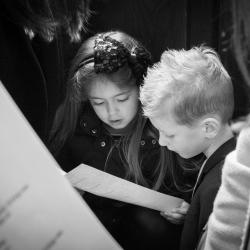Heilige Servatius
Oijen, NL
Interesting modern church with tower. Replaced the historic St. Servatius church, which was converted into a neoclassical church in 1837. Wide hall church with a sloping roof towards the entrance and placed against an outbuilding and a tower that tapers upwards, built in 1964-1965 to a design by the architects JHW and HPM Elemans from Oss. Typical of the construction period is that all liturgical functions are housed on one wide podium.






